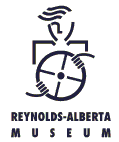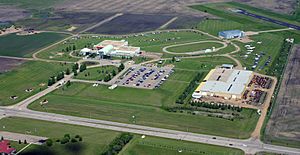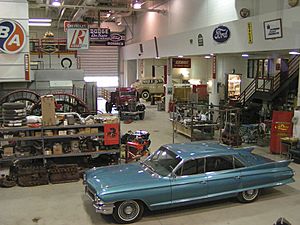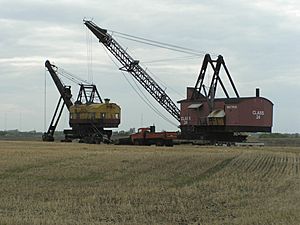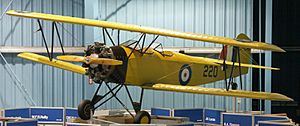Reynolds Museum facts for kids
 |
|

Exterior of the museum's main building
|
|
| Established | 12 September 1992 |
|---|---|
| Location | 6426 40 Avenue Wetaskiwin, Alberta, Canada |
| Type | Agricultural, industrial, transportation |
| Architect | RPK Architects |
| Owner | Government of Alberta |
The Reynolds-Alberta Museum is a cool place in Wetaskiwin, Alberta, Canada. It's a museum that shows off amazing old machines. You can see agricultural (farm) equipment, industrial machines, and all kinds of transportation. This includes cars, airplanes, and more! The museum sits on a huge property, about 89 hectares (that's like 220 football fields!). It has a main building, a special hangar for planes, and a big storage area.
The idea for the museum came from a man named Stan Reynolds. He loved collecting old farm machines, airplanes, and cars. He gathered a huge collection in the middle of the 1900s. In the 1980s, Mr. Reynolds gave 850 of his items to the government of Alberta. He wanted them to be shown in a public museum. The government opened the Reynolds-Alberta Museum on September 12, 1992. The museum was named after Stan Reynolds. He ended up donating over 1,500 items to the museum before he passed away.
Today, the museum has more than 6,600 items! These include agricultural, industrial, and transportation artifacts. Most of these items are kept in the museum's storage building. However, many are on display in the main museum building and the aviation hangar. Some items even travel to other places for special shows.
Contents
History of the Museum
The museum's first collection came from Stan Reynolds himself. He got many farm machines, airplanes, and cars through trade-ins at his car dealership. By 1955, he had so many vehicles that he opened his own "private museum." He really wanted his collection to be shown forever in a public museum. So, in 1974, he started talking to the government about donating his items. Between 1981 and 1986, he gave 850 artifacts to the government of Alberta. This was the biggest donation of its kind in Canadian history!
On September 12, 1992, the government of Alberta opened the Reynolds-Alberta Museum. It was created to show off all the items Stan Reynolds had donated. The museum was run by Alberta Culture, Multiculturalism, and Status of Women. The Canada's Aviation Hall of Fame also moved into the Reynolds-Alberta Museum when it opened. It stayed there until 2022, when it moved to The Hangar Flight Museum in Calgary. Stan Reynolds kept donating items even after the museum opened. In 1999, he gave another 60 aircraft. This was the largest donation of old airplanes in Canadian history!
In 2017, the government announced plans to make the museum even bigger. They wanted to add about 97,000 square feet and build a new storage place for airplanes. The federal government also promised money for this project in 2019. However, in March 2020, the expansion plans were put on hold.
What's at the Museum Site?
The museum is on a large 89-hectare property in Wetaskiwin, Alberta. It's right next to the Wetaskiwin Regional Airport. There are three main buildings on the property. These are the main museum building, the aviation display hangar, and the collections storage building. RPK Architects designed these museum buildings.
The Main Museum Building
The main museum building is very big, about 9,450 square meters (that's over 100,000 square feet!). This is where you'll find the museum's main exhibits. The exhibits show many items from the museum's collection. There are also fun, interactive displays. These displays teach you how machines changed life in Alberta from the 1890s until now. You can explore a 1911 car assembly line, a 1920s grain elevator, a 1930s service station, and even a 1950s drive-in theatre.
The main building also has a theatre, offices, a café, and a gift shop. There's a special workshop where they fix and restore old vehicles. Plus, there's a library and resource center. This library has books and information about transportation and farm machinery. It holds over 1,800 books and 18,000 trade literature items.
The Aviation Display Hangar
The aviation display hangar is about 1,830 square meters (nearly 20,000 square feet). It's connected to the Wetaskiwin Regional Airport. This hangar is used to show off the airplanes from the museum's collection. The Canada's Aviation Hall of Fame was located here from 1992 until 2022. It then moved to The Hangar Flight Museum in Calgary.
The Collections Storage Facility
The collections storage facility is the biggest building, at 10,219 square meters (over 110,000 square feet). This is where most of the museum's items are kept when they are not on display. The public usually can't go into this building. However, the museum does offer special private tours sometimes.
Museum Collections
The museum's collection started with Stan Reynolds' private items. He donated many things to the government in 1981. Then, he continued to donate to the museum after it opened in 1992. Stan Reynolds gave about 1,500 items to the museum before he passed away in 2012. Besides his donations, the museum also buys items or receives gifts from people and the Reynolds Heritage Preservation Foundation.
As of April 2019, the museum had about 6,600 items. These include agricultural, industrial, and transportation artifacts. The collection also has many documents about machines used in industry and transportation. More than 100 major items are on display in the main museum building. But over 5,000 items are stored in the collections storage facility. Some items also travel around as part of the museum's special tour program.
Agricultural and Industrial Items
The museum has 350 agricultural machines and 455 industrial items. This includes a Bucyrus-Erie 200-B power shovel and a Bucyrus Class 24 dragline from 1929. The Bucyrus Class 24 is the oldest working dragline excavator in the world!
Transportation Vehicles
The museum's transportation collection has 537 cars, motorcycles, and trucks. Some cool cars you might see include a Hupp-Yeats, a 1929 Duesenberg Phaeton Royale Model J, and a 1933 Ford Fordor. They also have one of only two surviving 1934 Citroën P17 half-track vehicles. These were used during the Bedaux expedition. The world's oldest known Chevrolet, a 1913 Chevrolet Series C Classic Six, is also part of the collection. Newer vehicles include the BugE, an electric car donated to the museum. In 2018, the museum got one of the two McLaughlin-Buick cars used by the royal family during their 1939 tour of Canada. They also received other items from that tour.
Aircraft Collection
The museum also has 135 aircraft. This makes it the second-largest collection of airplanes in Canada! Only the Canada Aviation and Space Museum has more. The museum also has the full-size Avro Arrow model. This model was used in The Arrow TV miniseries.
Resource Centre
The museum's resource centre has the biggest public library of trade literature in North America. It has over 70,000 items! These include service manuals, parts catalogs, technical leaflets, magazines, and books.
See also
- List of museums in Alberta
- List of transport museums


